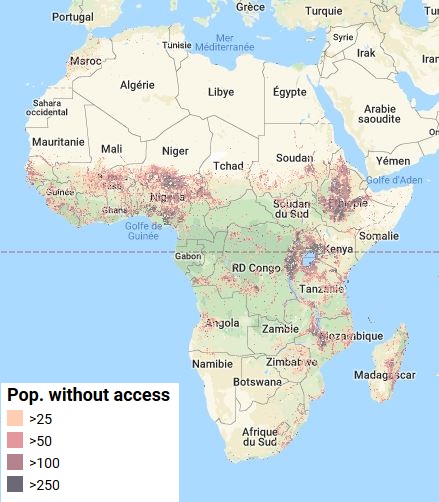On the basis of data from the IEA WEO 2018, considerable progress has been made in recent years in the field of access to energy and more specifically in the field of access to electricity. In 2017, for the first time, the population without access to electricity fell below the billion mark.
However, this positive global vision hides a particularly worrying heterogeneity. In sub-Saharan Africa, the access rate, which stood at 43% in 2016, will certainly continue to increase, but the number of people without access to electricity is on the rise again in this part of the world and, according to the IEA, of the 674 million people without access in 2030, 90% of them will live in sub-Saharan Africa.
Population without electricity per km², 2018.

Source : International Institute for Applied Systems Analysis (IIASA), Falchetta et al. 2019 (https://www.nature.com/articles/s41597-019-0122-6.pdf
Over the period 2000-2016, most of the access gains were achieved through the creation or extension of new networks, but were not entirely satisfactory with regard to the SDGs or the needs of the target populations. Indeed, on the one hand, and not surprisingly, fossil fuels remain the main mode of production, even if the share of renewable energy is increasing at the end of this cycle and, on the other hand, the reliability of these networks in sub-Saharan Africa does not offer the required service quality (Millien, 2017 : Electricity supply reliability and households decision to connect to the grid”).
Reliability of supply and transparency of tariff index (0-8)

Source : Doing Business 2019, World Bank
Finally, for reasons of geography and population dispersion, these networks leave entire parts of the countries’ territory with large rural population off-grid.
Existing and Planned Networks in West Africa, 2019

Source : ECREEE
The development of decentralized solutions for these populations that cannot be connected to the national network is therefore an essential challenge for the coming years.
As the costs associated with this type of installation are becoming competitive, benefiting strongly from advances in solar technologies and storage capacities, this type of solution will represent by 2030 an increasingly important share of new electricity access in Sub-Saharan Africa (already 34% of new connections since 2012 according to the IEA), whether in the form of off-grid or mini grid solutions.
While in urban areas, grid connection will remain the best way to access electricity, by 2030 decentralized solutions should offer rural (or even peri-urban) populations the most economical and secure way to access this essential service. Their adaptability to contexts, environments and uses should make it easier to mobilize financing based on the positive impacts that can be expected from this access to a modern and sustainable energy resource.
However, today, these solutions are often the result of a combination of factors and this heterogeneity does not facilitate the identification of “good practices” for maximizing the impact on populations. Given the relatively new nature of these solutions, there is a lack of hindsight on what these good practices could be, especially since recent evaluative studies have focused on the most basic segment, small individual solutions such as solar home systems (SHS), to the detriment of evaluating more ambitious collective solutions such as mini grids (Berthelemy et Béguerie, 2016 : Electrification décentralisée et développement, Numéro spécial FACTS Report, Institut Veolia et Ferdi).
Especially since in addition to the technical and economic heterogeneity there are many questions about governance methods in the case of mini-networks. In this respect, Elinor Ostrom’s work should apply to those local public goods that require the choice of an appropriate and effective local governance to solve the problems known as the “tragedy of the commons” (Berthelemy, 2016 : Les mini-réseaux électriques comme exemple d’application des thèses d’Elinor Ostrom sur la gouvernance polycentrique de la tragédie des communs). But too little work has been done to verify in practice the adaptability to the electricity sector of Ostrom’s conclusions on the traditional management of local natural resources.
However, scaling up will only be possible if these best technological, economic and governance choices are identified and these choices can only be made by maximizing the social and economic impacts on populations who, through electricity, will benefit from an essential means of economic transformation that goes well beyond the needs of households for lighting and charging mobile phone batteries.
To hope for the scaling-up, it is this maximization of impacts that must be targeted.
But for this to happen, scientific evaluation data would have to be available, and this is one of the analytical difficulty. These last 10 years have certainly allowed a first phase of capitalization based on impact studies of SHS-type projects, but these scientific studies are relatively few in number compared to the available evaluative studies. They are even very rare on collective solutions of greater power such as mini-grids.
On the basis of a major survey of this research work, a first data base has been created, the «Collaborative Smart Mapping of Mini-grid Action» (CoSMMA) by FERDI, which will be available online in mid-November 2019. Based on the CoSMMA, a meta-analysis made it possible to draw the first lessons from the accumulated experience. It highlights the predominant role that photovoltaic energy and collective solutions based on local governance methods should play, thus highlighting initial conclusions on good practices with regard to the impacts of economic transformation and improving the quality of life of populations (Berthelemy and Millien, 2018 : Impact of decentralized electrification projects on sustainable development: A meta-analysis”; Berthelemy, 2019 : Challenges of decentralized electrification for economic development: lessons from experience).
Investment needs to provide access to electricity for all in Africa alone amount to at least USD 20 billion per year and probably more. Decentralized solutions based on solar production are already among the most economical and will therefore undoubtedly represent an important part of new African projects. But to realize this scaling up decisive action in favor of decentralized electrification are necessary. These actions will be based on best practices that have been identified through better and more detailed impact measurement and will help to limit the heterogeneity of available solutions.
To this end, further work must be carried out on the basis of exploitable scientific data, the collection of which must be increased. It is the necessary condition to attract the necessary investments, lower the cost of access for the user and offer the most vulnerable access to electricity that can, in the spirit of the SDGs, help them out of poverty by improving their food security and health situation as well as by providing them with employment opportunities, or by improving their children’s learning conditions in school.
This analysis of the socio-economic impacts of decentralized electrification solutions requires that we give ourselves the means to collect scientific data useable to assess the impacts of small isolated projects at an affordable cost. This is the challenge of tomorrow that the players in the sector have not yet taken up.
